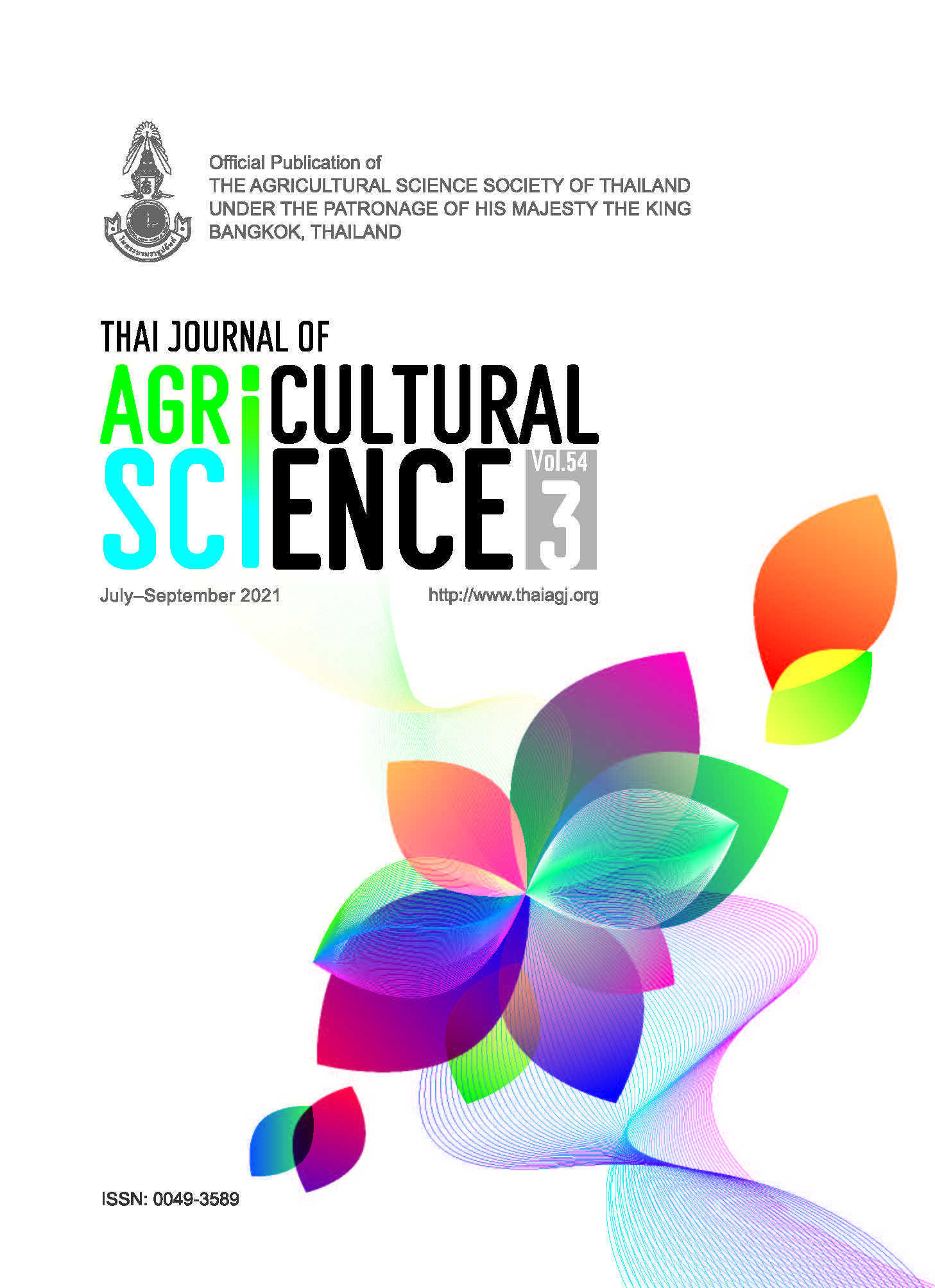Plant parasitic nematodes associated with banana (Musa spp. var. ‘Nendran’ AAB) – a diversity analysis at banana fields in Ottappalam Taluk of Kerala, India
Main Article Content
Abstract
Plant parasitic nematodes were documented as one of the major constraints in world food production. Efforts to understand the relations of the hosts and parasites will help to develop viable management strategies. In this aspect, a research survey was conducted during the post-monsoon season of 2017 in Ottappalam Taluk of Kerala, India to investigate the occurrence and population abundance of plant parasitic nematodes associated with an important crop banana (Musa var. ‘Nendran’ AAB). An extensive and in-deep survey for banana nematodes for this agricultural region of Kerala is not yet done. A total of 21 rhizosphere soil samples and root samples each were collected and processed for this study. Analysis for the plant parasitic nematode community showed variable degree of occurrence of viz. Aphelenchus spp., Dorylaimoides spp., Helicotylenchus spp., Hoplolaimus spp., Meloidogyne spp., Pratylenchus spp., Radopholus spp., Rotylenchulus spp., Rotylenchus spp., and Tylenchus spp. in both soil and root samples. Random surveys and their data analysis were done with absolute frequency distribution (%), absolute density (%), prominence value, and ANOVA (P = 0.05). The values for absolute frequency distribution (%), absolute density (%), and prominence value of the genus Meloidogyne spp. were 85.71%, 1,128.57%, and 10,448.54 respectively for rhizosphere soil samples and were 71.43%, 985.71%, and 8,330.85 respectively for root samples in banana fields of Ottappalam Taluk, revealed the more widespread occurrence of this genus in banana fields of Ottappalam Taluk. At the same time, maximum diverse numbers of nematodes were reported from Sreekrishnapuram panchayath and Kadambazhipuram panchayath for soil and root samples respectively. These findings were very much informative for the data addition about nematode fauna diversity studies of the agriculture sector, especially for the crop banana.
Article Details

This work is licensed under a Creative Commons Attribution-NonCommercial-NoDerivatives 4.0 International License.
References
Araya, M., D. De Waele and R. Vargas. 2002. Occurrence and population densities of nematode parasites of banana (Musa AAA) roots in Costa Rica. Nematropica. 32(1): 21–33.
Biswas, B.C. and L. Kumar. 2010. High density planting: success stories of banana farmers. Fertiliser Marketing News. 41(6): 3–10.
Cobb, N.A. 1918. Estimating the Nema Population of Soil, with Special Reference to the Sugar-beet and Root-gall Nemas, Heterodera schachtii Schmidt and Heterodera radicicola (Greef) Müller, and with a Description of Tylencholaimus aequalis n. sp. Agricultural Technology Circular, Bureau of Plant Industry, United State Department of Agriculture, Washington, DC, USA.
Keating, B.A., P.S. Carberry, P.S. Bindraban, S. Asseng, H. Meinke and J. Dixon. 2010. Eco-efficient agriculture: concepts, challenges, and opportunities. Crop Sci. 50: S-109–S-119.
Khan, M.R. and M.A. Hasan. 2010. Nematode diversity in banana rhizosphere from west Bengal, India. J. Plant Prot. Res. 50(3): 263–268.
Khan, M.R., R.K. Jain, R.V. Sing and A. Pramanik. 2010. Economically Important Plant Parasitic Nematodes Distribution: Atlas. Directorate of Information and Publications of Agriculture, Indian Council of Agricultural Research, New Delhi, India.
Lambert, K. and S. Bekal. 2002. Introduction to plant-parasitic nematodes. Plant Health Instr. 10: 1094–1218.
Nadakal, A.M. 1964. Studies on plant parasitic nematodes of Kerala. III. An additional list of plants attacked by root knot nematode, Meloidogyne sp. (Tylenchoidea: Heteroderidae). J. Bombay Nat. Hist. Soc. 61(2): 467–469.
Nicol, J.M. 2002. Important nematode pests, In: B.C. Curtis, S. Rajaram and H. Gómez Macpherson, (Eds), Bread Wheat: Improvement and Production. FAO Plant Production and Protection Series. No. 30. Food and Agriculture Organization of the United Nations, Rome, Italy.
Norton, D.C. 1978. Ecology of Plant-Parasitic Nematodes. John Wiley & Sons, Inc., New York, USA.
Powell, N.T. 1971. Interaction of plant parasitic nematodes with other disease-causing agents, pp. 119–136. In: B.M. Zuckerman, W.F. Mai and R.A. Rohde, (Eds), Plant Parasitic Nematodes. Volume 2. Academic Press Inc., London.
Roy, K., S. Roy, S. Sarkar, A. Rathod and A. Pramanik. 2014. Diversity of migratory nematode endoparasites of banana. J. Crop and Weed. 10(2): 375–391.
Sayed Abdul Rahman, S.A., S.N. Mohd Zain, M.Z. Bilal Mat, A.K. Sidam, R.Y. Othman and Z. Mohamed. 2014. Population distribution of plant-parasitic nematodes of bananas in Peninsular Malaysia. Sains Malays. 43(2): 175–183.
Southey, J.F. 1986. Laboratory Methods for Work with Plant and Soil Nematodes. Ministry of Agriculture, Fisheries and Food, H.M. Stationery Office, London.
Speijer, P.R. and D. De Waele. 1997. INIBAP Technical Guidelines. 1. Screening of Musa Germplasm for Resistance and Tolerance to Nematodes. International Network for the Improvement of Banana and Plantain, Montpellier, France.
Srinivasan, R., S. Kulothungan, P. Sundararaju and C. Govindasamy. 2011. Biodiversity of plant parasitic nematodes associated with banana in Thanjavur district of Tamil Nadu. Int. J. Plant Anim. Env. Sci. 1(2): 63–69.
Tarjan, A.C., R.P. Esser and S.L. Chang. 1977. Interactive diagnostic key to plant parasitic, free living and predaceous nematodes. J. Water Pollut. Control Fed. 49: 2318–2337.
UNEP (United Nations Environment Programme). 2000. Montreal Protocol on Substances that Deplete the Ozone Layer. Report of the Technology and Economic Assessment Panel. April 2000. Ozone Secretariat, Nairobi, Kenya.
Williamson, V.M. and A. Kumar. 2006. Nematode resistance in plants: the battle underground. Trends Genet. 22: 396–403.


